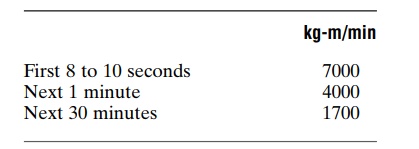Chapter: Medical Physiology: Sports Physiology
Muscles in Exercise: Strength, Power, and Endurance of Muscles
Muscles in Exercise
Strength, Power, and Endurance of Muscles
The final common determinant of success in athletic events is what the muscles can do for you—what strength they can give when it is needed, what power they can achieve in the performance of work, and how long they can continue their activity.
The strength of a muscle is determined mainly by its size, with a maximal contractile force between 3 and4 kg/cm2of muscle cross-sectional area. Thus, a man whois well supplied with testosterone or who has enlarged his muscles through an exercise training program will have correspondingly increased muscle strength.
To give an example of muscle strength, a world-class weight lifter might have a quadriceps muscle with a cross-sectional area as great as 150 square centimeters. This would translate into a maximal contractile strength of 525 kilograms (or 1155 pounds), with all this force applied to the patellar tendon. Therefore, one can readily understand how it is possible for this tendon at times to be ruptured or actually to be avulsed from its insertion into the tibia below the knee. Also, when such forces occur in tendons that span a joint, similar forces are applied to the surfaces of the joint or sometimes to ligaments spanning the joints, thus accounting for such happenings as displaced cartilages, compression frac-tures about the joint, and torn ligaments.
The holding strength of muscles is about 40 per cent greater than the contractile strength. That is, if a muscle is already contracted and a force then attempts to stretch out the muscle, as occurs when landing after a jump, this requires about 40 per cent more force than can be achieved by a shortening contraction. Therefore, the force of 525 kilograms calculated above for the patellar tendon during muscle contraction becomes 735 kilograms (1617 pounds) during holding contractions. This further compounds the problems of the tendons, joints, and ligaments. It can also lead to internal tearing in the muscle itself. In fact, forceful stretching of a max-imally contracted muscle is one of the surest ways to create the highest degree of muscle soreness.
Mechanical work performed by a muscle is the amount of force applied by the muscle multiplied by the distance over which the force is applied. Thepower of muscle contraction is different from muscle strength, because power is a measure of the total amount of work that the muscle performs in a unit period of time. Power is therefore determined not only by the strength of muscle contraction but also by its distance ofcontraction and the number of times that it contracts each minute. Muscle power is generally measured in kilogram meters (kg-m) per minute. That is, a musclethat can lift 1 kilogram weight to a height of 1 meter or that can move some object laterally against a force of 1 kilogram for a distance of 1 meter in 1 minute is said to have a power of 1 kg-m/min. The maximal power achievable by all the muscles in the body of a highly trained athlete with all the muscles working together is approximately the following:

Thus, it is clear that a person has the capability of extreme power surges for short periods of time, such as during a 100-meter dash that is completed entirely within 10 seconds, whereas for long-term endurance events, the power output of the muscles is only one fourth as great as during the initial power surge.
This does not mean that one’s athletic performance is four times as great during the initial power surge as it is for the next 30 minutes, because theefficiency for translation of muscle power output into athletic per-formance is often much less during rapid activity than during less rapid but sustained activity. Thus, the veloc-ity of the 100-meter dash is only 1.75 times as great as the velocity of a 30-minute race, despite the fourfold dif-ference in short-term versus long-term muscle power capability.
Another measure of muscle performance is endurance. This, to a great extent, depends on the nutri-tive support for the muscle—more than anything else on the amount of glycogen that has been stored in the muscle before the period of exercise. A person on a high-carbohydrate diet stores far more glycogen in muscles than a person on either a mixed diet or a high-fat diet. Therefore, endurance is greatly enhanced by a high-carbohydrate diet. When athletes run at speeds typical for the marathon race, their endurance (as meas-ured by the time that they can sustain the race until complete exhaustion) is approximately the following:

The corresponding amounts of glycogen stored in the muscle before the race started explain these differences. The amounts stored are approximately the following:

Related Topics